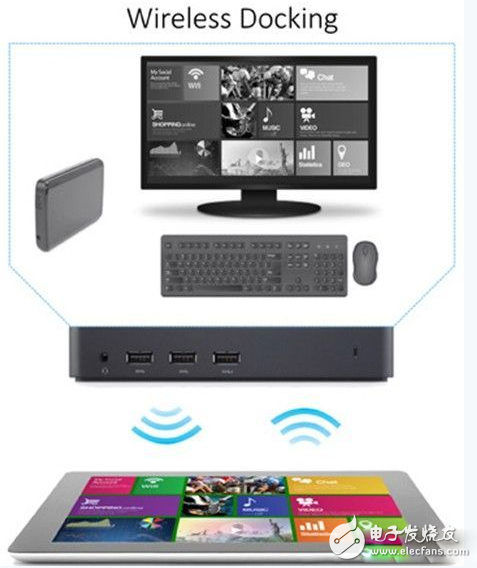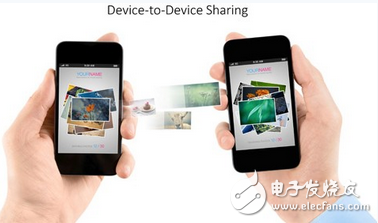The rigors of today's digital world are nothing more than data processing, storage and transmission. As mobile devices supporting full HD (FHD) video streaming and 4K video are becoming mainstream, consumer demand for data bandwidth continues to grow exponentially.
At this stage, the third-generation universal serial bus (USB3.0) and Ethernet (Ethernet) and other wired data interfaces have reached the Gbit/s transmission rate, but in terms of wireless transmission, 2.4GHz and 5GHz wireless local area networks (Wi -Fi) technology, the current frequency band is already very crowded and difficult to expand.
With this in mind, the development of 802.11ad wireless solutions using 60 GHz unlicensed bands is emerging, providing a broadband network with multi-gigabit data bandwidth, ideal for future consumer needs. In this case, readers who are unfamiliar with the band specification are specifically stated that the unlicensed band is provided by the local band regulator and the user is not required to pay the regulatory authorization fee. Wi-Fi operates on 2.4GHz, 5.0GHz and new 60GHz unlicensed bands.
Realize the tri-band Wi-Fi vision 802.11ad to develop wireless applications
The IEEE 802.11ad standard, known for its multi-gigabit Wi-Fi, was released in December 2012 and offers wireless data rates of up to 7 Gbit/s. Recently, the industry and the Wi-Fi Alliance (Wi-Fi Alliance) and its partners promoted 802.11ad, and began to use the Gigabit capacity brought by 802.11ad for various new wireless interconnection solutions.
802.11ad solves the problem of band crowding while improving the appearance of the device and industrial design and provides a better user experience than other wireless technologies. The first is a new generation 2.4GHz/5.0GHz/60GHz tri-band Wi-Fi wireless network that can increase the speed of wireless interconnects to gigabits, creating a new indoor wireless experience; consumers can use 802.11ad-enabled smartphones. Connect to a wireless connection point (AccessPoint) and exchange data with other 802.11ad-enabled devices such as tablets, laptops, monitors, network storage servers (NAS), etc. (Figure 1). As a result, consumers don't have to wait for a long time, just a few seconds to import a complete media library or download a complete movie.

Figure 1 Tri-band Wi-Fi application scenario diagram
At the same time, 802.11ad will take the mobile experience to the next level. As mobile devices such as smartphones and tablets perform as well as PCs, users only need to carry mobile devices and connect to a larger or multiple monitors, keyboards, mice, and versatile disk drives via a wireless network. Work (Figure 2). All information between the mobile device and the cradle can be transmitted over an 802.11ad Gigabit wireless connection.

Figure 2 wireless docking station application concept map
Thus, the era of using mobile devices to achieve all computing, Internet, entertainment and gaming functions has arrived, and 802.11ad will bring many opportunities to the wireless connectivity market, whether it is to achieve a wireless desktop PC experience in the office or a home. 4K video stream.
In addition, travelers can enjoy excellent synchronization and mobile situational experiences while on the go, such as using 802.11ad-enabled devices to quickly back up data to a host or download a movie from an information service station before boarding, or share files with friends. (image 3). 802.11ad's gigabit data transfer allows devices to transfer files in seconds, saving time to handle more important transactions.

Figure 3 device-to-device high-speed data sharing
60GHz application gradually emerging 802.11ad chip expanded appearance
As 802.11ad applications become more and more clear, communication chip vendors are beginning to expand their technology and product layout. For example, SiBEAM offers three 802.11ad-enabled components, including 802.11ad's Media Access Control Layer (MAC)/baseband processor SB6501, 60GHz RF transceiver SB6510 for mobile (DC battery-powered) applications, and fixed devices. (AC power supply) 60 GHz RF transceiver Sil6312; SB6501 provides dual antenna array, which enhances the wireless stability required to connect to mainstream system single-chip (SoC) platforms and achieve a more flexible data interface.
At this stage, most of the 802.11ad chips on the market have built-in key RF circuits and a variety of built-in antennas to provide excellent wireless performance, stability and excellent design flexibility, and support different from mobile devices, network devices to displays. The size of the device; at the same time allows original equipment manufacturers (OEMs) to select and add MAC/baseband processors and RF chipsets for different applications.
For mobile applications such as consumer electronics, users will be able to hold the device horizontally or vertically. OEMs can choose to add a second 802.11adSB6510 RF IC to the device to enhance antenna density and enhance the stability of the wireless connection. For wireless transmission products that are powered by AC power, such as televisions, wireless routers, or storage devices, system operators can use 802.11ad chips that support AC power.
The latest 802.11ad RF chipset integrates a power amplifier (PA), low noise amplifier (LNA) and multiple phased array antennas in a single component. Taking SiBEAM's 802.11ad solution as an example, its patented built-in antenna is integrated in the baseband processor and independently controlled by adaptive beamforming and control algorithms to improve wireless connection performance and stability.
Unlike the 2.4 GHz and 5 GHz Wi-Fi bands, beamforming and control functions in the 60 GHz band play a more important role in maintaining link performance and stability. The baseband and the antenna array work together to "form" and "control" the beams between two continuously communicating devices, and the two interworking devices are interconnected with multiple antenna arrays at any time, and only one link is used for transmitting and receiving data; If the active link is suddenly interrupted, another established link is enabled to keep the wireless connection uninterrupted. All of the above features are implemented through the latest 802.11ad solution on the market, which is very easy for users.
On the other hand, 802.11ad RF chips must also support USB 3.0 and PCIe 1.0 interfaces to connect with mainstream application processors; currently, related chip vendors are actively developing 802.11ad reference designs and standard design modules to help system manufacturers 802.11ad functionality can be added to its platform in a short period of time and is available for different devices.
With more than one billion smartphones shipped each year and more and more devices become part of the Internet of Things (IoT), Wi-Fi will only use less bandwidth in the overcrowded 2.4GHz and 5GHz bands. It has gotten worse. Therefore, wireless industry members, including OEMs, network operators, solution providers and local regulators, are actively looking for other bands such as 60 GHz to expand services.
Consumers are also looking forward to the next generation of wireless technology to solve the problem of congestion in the Wi-Fi band and provide a new user experience. The communications industry supply chain has seen the potential of 802.11ad technology and is embarking on a solution that will provide the most cost-effective 802.11ad designs for customers in the mobile, PC, networking and consumer electronics markets.
The bulbs are installed inside of a vehicle. There are many different types of interior bulb. Interior lights for indoor lighting are usually installed in the center of the car interior. It's better to light up the car interior evenly. In addition, the light switch (SW) should be operated on both front and rear seats at the time of layout. SW generally has ON, OFF, and door linkage 3 locations. In order to reduce the thickness of the lamp, 5-10w bulb bulbs are usually used. To meet the illumination requirement of capacious indoor, the power of the bulb that uses is commonly 8~30W. The original reading light in the car is designed to read the map. In order to drive the driver, read the light and light up to the point, only on the required part. The rear reading lamp is the rear seat special reading light, with a larger point light illumination. Be careful not to give the driver and other passengers a sense of vertigo. The light can be connected to the door and switch. When the door is open, the lamp is mounted on the door to illuminate the foot part of the room and the outside foot. In order to give the signal to the back of the car, the installation position should be considered. The lamp has no special switch, but is connected with the door.
Auto Interior Lamp Bulb
Auto Interior Lamp Bulb,Car LED Auto Light,LED Reading Light,Interior Dome Light
SHINING BLICK ENTERPRISES CO., LTD. (Heshan Jianhao Lighting Industrial Co., Ltd.) , https://www.sunclubtw.com